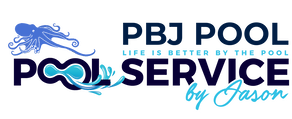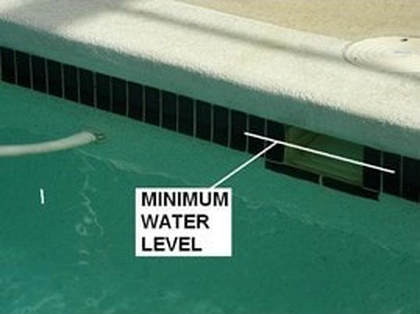 This is the most common question homeowners ask me, and it’s the most basic one. Weather someone is new to being a pool owner or a veteran pool owner, I’m often asked. Where should I keep the water level. For pool owners that have an automatic pool water leveler this is a set it and forget it situation baring any problems with your automatic leveling system which should be checked monthly by your pool service. Often we find the older auto fill systems have worn or broken parts and the float needs replaced the more recent ones are more durable and sustainable. Ideally for best results you want your pool water level 1/3 to ½ way up the skimmer throat. This is the opening in your tile where the surface debris is skimmed or sucked off the surface. Water level too high and the water flow is slowed down to the point that debris can pass right by the skimmer opening without being sucked inside and filtered.
Too low of a water level and the pump will lose its prime and you are risking possible damage to your pool pump from overheating and running dry, a very costly repair. You also will experience unhealthy swimming conditions from lack of circulation and filtration. If you have a salt chlorination system your salt cell will only produce chlorine with consistent flow high enough to trigger the flow switch. All of which will lead to an algae bloom. If you are unsure where to keep your pool water level, please don’t hesitate to ask your pool service or a pool professional. 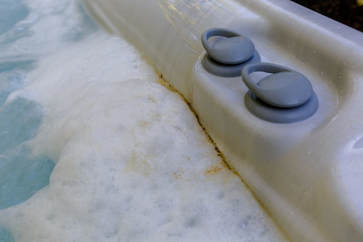 Why professional pool and spa service technicians recommend draining and refilling your spa with fresh water at least every three months.
Homeowners always ask, is that really necessary? do we have to? the short answer is in order to maintain clean healthy safe water, YES. Along with scheduled filter cleanings, the proper water balance should test as follows (we recommend the Taylor Technologies test kit k-1003 for homeowners) pH 7.4-7.6, Bromine 4-6ppm, Total Alkalinity 80-120 ppm, Calcium Hardness 150-200 ppm, 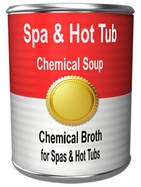 An average bather in a hot tub / spa will bring with them over 100 million bacteria into the water while bathing, joining the already present organisms living in the water from previous bathing, organisms such as bio-film, (bacteria are harbored in bio-film which protects them from disinfectants) parasites, virus, algae, mold, mildew, spores. Compound that with human wastes such as urine, sweat, mucous, tears, saliva, and other bodily fluids. Can you see where this is going? Yuck. But wait we are not done with our recipe. We forgot the man-made products, some examples of these are soaps, oils, lotions, make up, hair products deodorants, anti-perspirants, and perfumes.
Some of the largest organic components of sweat and urine are creatinine. Creatinine is a waste product that comes from the normal wear and tear on muscles of the body. Everyone has creatinine in their bloodstream. When this creatinine combines with chlorine or bromine they produce N-chloro or N-bromo compounds referred to as chloramines and bromamines. These bromamines and chloramines require HUGE amounts of oxidization to destroy and get rid of them. 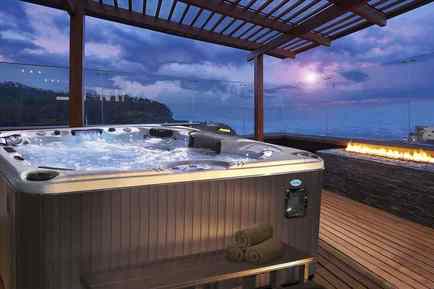 I could go into a lot more detail that will just confuse you with chemical reactions between oxidizers and organic materials that produce trihalomethanes such as chloroform dibromochloromethane and bromoform and the byproducts of these such as cyanogen, halide, halopicrines, haloacetic acids and haloketones, but let’s get out of bio lab and back on track. Regardless of what we professionals call them, chlorine and bromine in spa water eventually become chlorides and bromides and raise the TDS (total dissolved solids) level of the water. There are over 20 tests that can be performed on your pool and spa water, however many are not always necessary in normal situations. Pool and spa water need to test 7 (Total chlorine/bromine, free chlorine / bromine, Total Alkalinity, pH, Calcium Hardness, TDS, Cyanuric Acid) of the 7 tests, three are very slow to change and need testing less often ( CYA, TDS, Calcium hardness) and the others ( pH , free chlorine, alkalinity) change rapidly and need to be monitored more frequently in some cases hourly in commercial spas. For residential homeowners I recommend weekly testing. I can hear you thinking to yourself Oh My goodness I need to drain and clean my spa now and fill with fresh water. Most likely yes you should.
This is one factor that definitely prevents most pool and spa professionals from EVER wanting to enter into a hotel or resort commercial spa. We know what’s in that water. 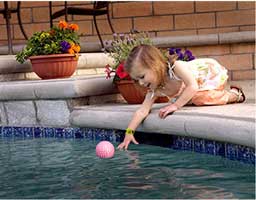 Drowning is to blame for nearly 30% of children’s deaths, drowning in a private pool is the second leading cause of death among teenagers. For the years 2014 through 2017, there were an average of 3,500 fatal unintentional drownings. An annual average of 6,200 children younger than 15 years of age were treated in U.S. hospital emergency departments for nonfatal injuries associated with pool or spa submersions. The majority of these incidents involve children younger than age 5. On average, more than 4,000 children under the age of 5 annually require emergency department treatment for pool and spa related non-fatal injuries. The majority of these children are between the ages of 1 and 3.  Although these statistics alone are frightening, they aren’t the only reasons why you should consider developing home swimming pool safety tips and rules for your family. For every drowning that occurs, there are 11 near drowning incidents, many of which result in disabling brain damage due to lack of oxygen supply to the brain. With all these statistics to consider, here is the most glaring of them all: roughly 70% of drowning incidents occurred when children were not adequately supervised. In other words, supervision is the best idea to protect your children from an accident around your pool. However, supervision isn’t 100% foolproof, and we all know mistakes and errors in judgment happen.
Pledge that you will... * Don't leave - even for a minute! Children can drown very easily and very quickly. Even if you leave for just a moment to answer the phone, or check the oven timer it can provide enough time for a traumatic accident to occur. If you must go inside, insist that all children get out and stay out of the water until you return. * Inform babysitters and nannies If you have a babysitter, or nanny watching your children, make sure they are aware of your safety measures regarding your pool and spa. Show them how to open, and close the gate around your pool and spa, how to manage your pool and spa cover if you have one, and make sure your babysitter or nanny is trained in CPR and first aid in the event of a pool accident. * Talk to your children Children, no matter how young should be aware of the dangers of a swimming pool and spa. Often the fear of an accident is enough to keep most children cautious. Explain that no running should ever take place around the swimming pool, no one should enter the water without an adult present, and to NEVER lean over the edge of the swimming pool to try and retrieve an item from the water. * Appoint a designated " watcher " during parties When adults have parties, often children also attend. A distracted adult can allow accidents to happen. Rather than risk it, have adults take turns keeping a careful watch on the swimming pool. If there are more than 6 or 7 children in the water, it is recommended to have two adults watch the pool at all times. * Keep a telephone & safety equipment near the swimming pool Unfortunately accidents can happen. Be Prepared. In case of an emergency, keep a telephone near the pool so you can quickly call 911. Every second counts. If a child appears to be in trouble, get that child and all other children out of the water immediately before calling 911. * Check the pool FIRST. If you notice one of your children missing, go check the pool first. Drowning can occur within minutes. Time is valuable. Go all the way to the edge of the swimming pool and scan the entire length of your pool including along all of the borders of your swimming pool and be sure to check your spa if you have one. * Never use a flotation device as a substitute for supervision * Knowing how to swim, does not make someone drown proof. * Never use a pool or spa with a missing or broken drain cover * Have a licensed swimming pool professional regularly inspect your pool and equipment * Clearly mark the location of the electrical cut-off switches to your swimming pool and spa pump * Place tables and chairs well away from your swimming pool fence to prevent children from climbing over * Make sure all suction outlets have approved covers to prevent entrapment * If someone becomes entrapped against a drain, cut-off the power to the pump immediately, do not attempt to pull them free from the powerful suction 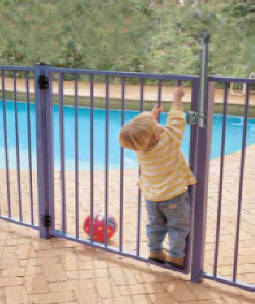 * Remove ALL pool toys from the pool after use. Children will be tempted to reach over the edge of the swimming pool for toys away from your presence( plus they will get sucked into your pool skimmer and can restrict the flow of your filter and pools circulation system) * Practice TOUCH SUPERVISION with all children under 6 years old. This means at all times your children are within arms reach of you * Learn CPR Animal / Pet Safety Equipment These are inexpensive pieces of equipment to keep all animals safe around your pool. These devices won’t tell you when an animal is in the pool, but it will help them get out on its own.
Popular Model: The Poolguard PGRM -2 and the new Coral Drowing Prevention systems Manta http://coraldrowningdetection.com/about/
|
AuthorWrite something about yourself. No need to be fancy, just an overview. Archives
August 2018
Categories
All
|
